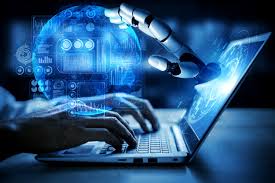Source:-analyticsinsight.net
In the mid-twentieth century when the computer and its applications were starting to bring changes to the world, sociologist David Reisman had something stuck in his mind. He wondered what people would do once machine automation comes to effect and humans have no compulsion to do daily physical chores and strain their brain to come up with solutions. He was excited to see what people would do with all the free time.
More than half a century later when the world has exactly what Reisman wondered, humans are still working on a full-time scale. Work alleviated by industrious machines such as robotics systems has only freed humans to create more elaborate new tasks to be laboured over. To counter attack all the predictions of the previous century, machines gave humans more time to work and not to relax.
Like how we currently imagine robots taking over the human society and doing all the work by themselves including physical and intellectual labour without human assistance as they are well programmed and set to adapt to any environment and take the accurate decision without human help, the previous century people too dreamed that robots will take over all the physical work during the era of the space race. But today, robots are used for their intelligence more vigorously than their physical assistance. Humans can only teach robots and make them follow instructions up to an extent. So when humans lack, machine learning makes its way to discipline robotics.
What is machine learning?
Machine learning is one of the advanced and innovative technological fields today in which robotics is being influenced. Machine learning aids robots to function with their developed applications and a deep vision.
According to a recent survey published by the Evans Data Corporation Global Development, machine learning and robotics is at the top developers’ priority for 2016. It is calculated that 56.4% of participants build robotic apps and 24.7% of them indicate the use of machine learning in their project.
Machine learning involves enormous caches of data to be taught to the robot for its perfect learning. The procedure contains algorithms and physical machines to aid the robots in the learning process.
Different disciplines of teaching a robot through machine learning
Deep Learning educates the purpose of the robot
Deep Learning has been in the machine learning field for more than 30 years. But it was recognised and brought into continuous use recently when Deep Neutral Network algorithms and hardware advancements started having high potential. Deep learning can be accomplished through computational capacity and the required datasets that are ultimately the powerful assets of machine learning.
The process of teaching robots machine learning necessitates engineers and scientists to decide how AI learns. Domain experts take the next role of advising on how robots need to function and operate within the scope of the task. They also specify the features of robots being of assistance at logistics experts and security consultants. Deep learning focuses on the sector that a robot needs to be specialised from its root.
Feeding robots with planning and learning
AI robots through machine learning acquire two important processes namely planning and learning. Planning is like a physical way of teaching robot that presumes the robots to work on what pace it has to move every joint to complete a task. For example, grabbing an object by a robot is a planning input.
Meanwhile, learning involves different inputs and reacts according to the data added to it on a dynamic environment. Learning process takes place through physical demonstrations in which movements are trained, stimulation of 3D artificial environments and feeding video and data of a person or another robot performing the task it is hoping to master for itself. The stimulation is a training data where a set of labelled or annotated datasets that an AI algorithm can use to recognize and learn from it.
Educating and training with accurate data
The process of educating a robot needs accuracy and abundance. Inaccurate or corrupt data is going to bring nothing except for chaos. Inaccurate data will lead to a robot drawing to the wrong conclusion. For example, if the database is focused on green apples, and you input a picture of a blueberry muffin, they would still get a green apple. This kind of data disruption is a major threat. Insufficient training data will bar the robot from acquiring the full potential it is designed to perform.
Reaping the maximum of physical help
Machine learning will push robots to do physical work at its best. Recently, these kinds of robots are used in industries for various purposes. For example, unmanned vehicles are stealing the spotlight at construction sites.
It is not just the construction sector that is reaping a handful of help from machine learning. Medical industry makes use of it by involving computer vision models to recognise tumours within MRIs and CT scans. Through further training, an AI robot will be capable of doing life-saving surgeries and other medical procedures through its machine learning input.
With the emergence of robots in the society, the opportunity of training data, machine learning and Artificial Intelligence (AI) are playing a critical role in bringing it to enforcement. Tech companies involved in the robot creating and training process should spend some time to sensitize people on the robots help to humanity. If things work well and the AI department comes up with advanced robots that are well-trained, built and purposed AI, Reisman’s dream of humans having leisure time could come true.
